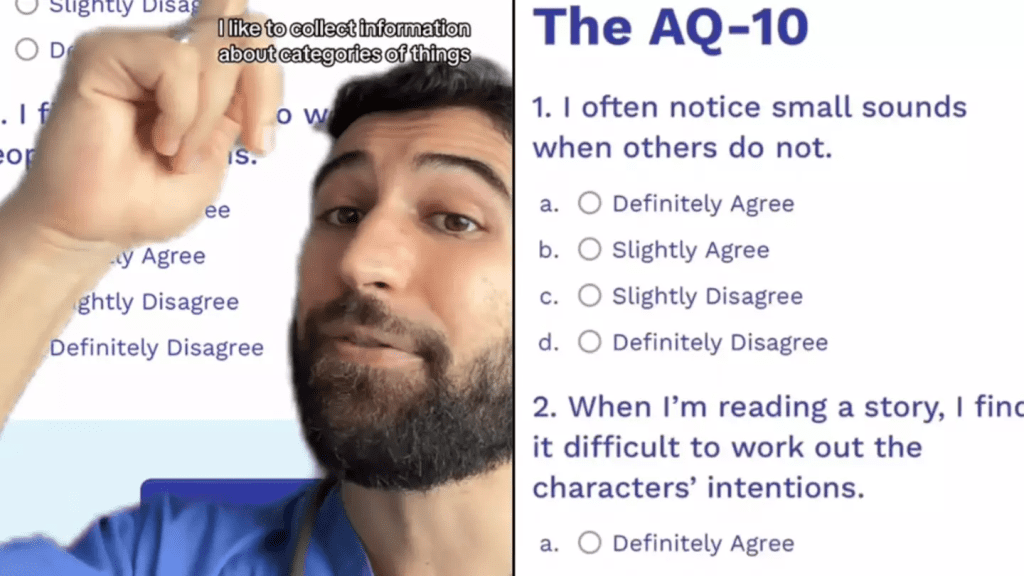Autism Spectrum Disorder (ASD) affects individuals differently, creating a range of unique strengths and challenges. As the NHS explains, autism isn’t an illness or a disease but rather a different way of processing the world. Recognizing autism early can help individuals receive the support they need to thrive. Recently, Dr. Sermed Mezher, a London-based doctor, shared a quick, preliminary screening tool on social media called the Autism Spectrum Quotient-10 (AQ-10) test. This brief set of questions can offer insights into whether someone may have autism, though it’s not a diagnostic tool.
What Is the Autism Spectrum Quotient-10 (AQ-10) Test?

The AQ-10 test consists of 10 specific questions designed to assess social communication, behavior patterns, and information processing traits associated with autism. Developed as a short screening measure, it highlights potential indicators of autism that may suggest further evaluation. Dr. Mezher emphasizes that the AQ-10 cannot confirm a diagnosis but can guide individuals toward seeking a comprehensive assessment if necessary.
Why Early Detection Matters in Autism Spectrum Disorder
Understanding autism early can be life-changing, especially in guiding support strategies tailored to each individual’s needs. While autism manifests differently across the spectrum, common challenges may include difficulties with social interaction, communication, and repetitive behaviors. Early detection allows for support that can improve communication skills, social engagement, and personal development.
The Top 10 Questions That Could Signal Autism Spectrum Disorder
Dr. Mezher shared the following questions from the AQ-10 test, designed to help individuals identify possible traits of autism. Here’s a closer look at these questions and how each could indicate a potential autism trait:
- I often notice small sounds when others do not.
- Why It Matters: Heightened sensory perception is common in autism. Individuals with ASD may experience intensified sounds, textures, or lights, often noticing details that others might miss.
- When I’m reading a story, I find it difficult to work out the character’s intentions.
- Why It Matters: Many people on the autism spectrum struggle to interpret non-literal language or infer intentions and emotions from characters, whether in books or real-life interactions.
- I find it easy to read between the lines when someone is talking to me.
- Why It Matters: Interpreting subtext or sarcasm can be challenging for individuals with ASD, who may prefer direct and literal communication.
- I usually concentrate more on the whole picture, rather than the small details.
- Why It Matters: People with autism often focus intensely on details rather than seeing the broader context, which can affect how they process information.
- I know how to tell if someone listening to me is getting bored.
- Why It Matters: Picking up on subtle social cues, like body language or tone changes, can be challenging for many on the autism spectrum, affecting social interactions.
- I find it easy to do more than one thing at once.
- Why It Matters: Multitasking is often difficult for those with ASD, who may find comfort in focusing on one task at a time to avoid feeling overwhelmed.
- I find it easy to work out what someone is thinking or feeling just by looking at their face.
- Why It Matters: Reading facial expressions and understanding emotions can be difficult for people with autism, impacting their ability to empathize in conventional ways.
- If there’s an interruption, I can switch back to what I was doing very quickly.
- Why It Matters: Changes in routine or unexpected interruptions can be especially disruptive for individuals with ASD, who often thrive on structure and predictability.
- I like to collect information about categories of things.
- Why It Matters: Many individuals with autism have specific interests or focus intensely on certain topics, leading them to collect detailed information on their preferred subjects.
- I find it difficult to work out people’s intentions.
- Why It Matters: Understanding others’ motivations or intentions can be a challenge for those with ASD, affecting relationships and social interactions.
Each “agree” response to questions like these might indicate traits associated with autism. According to Dr. Mezher, scores of six or higher suggest that an individual could benefit from a more comprehensive autism evaluation.
Why the AQ-10 Test Is Only a Preliminary Screening Tool
Dr. Mezher emphasizes that the AQ-10 test is merely a preliminary guide, not a definitive diagnosis. While it can highlight traits associated with autism, it doesn’t capture the full scope of the disorder. For an accurate diagnosis, in-depth assessments are essential. These may involve:
- Clinical Interviews: To understand individual developmental and social history.
- Behavioral Observations: Observing behavior in structured and unstructured settings to identify patterns.
- Cognitive and Language Tests: These can reveal strengths and challenges specific to each individual.
In combination, these assessments offer a clearer, more holistic picture of whether someone is on the autism spectrum.
How a Professional Diagnosis Can Help Individuals on the Spectrum
A formal diagnosis can provide access to resources, accommodations, and therapies that support the specific needs of someone with autism. While autism is a lifelong condition, early interventions can make a significant difference, enhancing communication skills, social understanding, and adaptability. Here are some common areas where support can be tailored:

- Social Skills Training: Helps improve social interactions, build relationships, and understand social cues.
- Occupational Therapy: Focuses on motor skills, sensory integration, and activities for daily living.
- Speech and Language Therapy: Supports language development and comprehension, particularly in interpreting non-literal language.
- Educational Supports: Ensures the learning environment accommodates an individual’s unique learning style.
Understanding autism can lead to a supportive environment both in personal and educational or professional settings, providing individuals with tools to navigate their world more effectively.
Autism: A Spectrum with Unique Strengths
It’s important to remember that autism affects everyone differently, with individuals displaying a wide range of strengths and challenges. While some may face difficulties with social situations, others excel in specific skills like math, memory, or visual thinking. Recognizing these strengths is just as important as understanding challenges, as it can help individuals with autism thrive in areas where they naturally excel.
The AQ-10 and similar tools can help guide individuals toward self-awareness, showing that autism, though often challenging, brings its own unique perspectives to the world. Embracing neurodiversity enriches communities by fostering creativity, innovation, and empathy.
Conclusion: Understanding Autism and Seeking Further Evaluation
The AQ-10 test offers a helpful first step for those curious about autism traits, though it’s not a substitute for professional diagnosis. Autism presents itself in diverse ways, and understanding these differences is key to supporting individuals on the spectrum. For anyone who resonates with the AQ-10 questions, a professional evaluation could provide clarity, enabling access to supportive resources that enhance quality of life. Embracing autism as a part of neurodiversity allows society to celebrate the unique ways in which every mind works, ultimately creating a more inclusive world.


